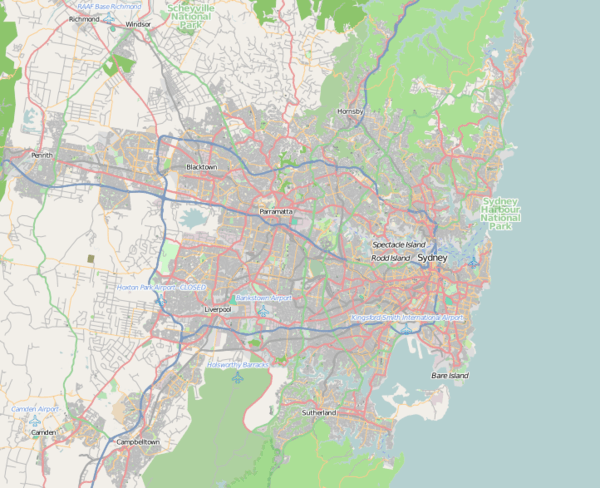Paddington Town Hall
| Paddington Town Hall | |
|---|---|
|
Paddington Town Hall | |
 Paddington Town Hall Location in Greater Sydney | |
| General information | |
| Type | Town hall |
| Architectural style | Victorian Free Classical |
| Address | 249 Oxford Street, Paddington |
| Town or city | Sydney, New South Wales |
| Country | Australia |
| Coordinates | 33°53′06″S 151°13′33″E / 33.885125°S 151.225792°ECoordinates: 33°53′06″S 151°13′33″E / 33.885125°S 151.225792°E |
| Current tenants |
|
| Construction started | 8 November 1890 |
| Completed | 1891 |
| Opened | 3 October 1891 |
| Renovated | August 1905 |
| Client | Municipality of Paddington |
| Owner | City of Sydney |
| Height | |
| Tip | 32-metre (105 ft) clock tower |
| Design and construction | |
| Architect | John Edward Kemp |
| Main contractor | R. Steele |
| Website | |
| cityofsydney.nsw.gov.au | |
| Official name | Paddington Town Hall |
| Criteria | a., c., d. |
| Designated | 2 April 1999 |
| Reference no. | 00561 |
The Paddington Town Hall is a town hall building located in the Sydney suburb of Paddington, New South Wales, Australia. Sir Henry Parkes laid its foundation stone in 1890 when Paddington was a separate municipality. It opened in 1891 and remains a distinctive example of Victorian architecture in Sydney. The clock tower, completed in 1905, is 32 metres (105 ft) high and is a prominent landmark on the ridge of Oxford Street.[1][2]
The building was listed on the New South Wales State Heritage Register on 2 April 1999 with the following statement of significance:[2]
The Paddington Town Hall is of State significance as a landmark example of the Victorian Free Classical architectural style. Located in a prominent location, the Town Hall is highly visible and, as a well maintained building, an aesthetically pleasing structure. The Town Hall's construction in 1891 marked the beginning of the 1890s depression as is historically significant as one of the last public buildings to be built in the style.
— Statement of significance, New South Wales State Heritage Register.
History and description
Situated at the highest point on the Oxford Street ridge, the town hall's foundation stone was laid on 8 November 1890 by Sir Henry Parkes and was opened with great fanfare on 3 October 1891 by the Governor, The Earl of Jersey.[2][3][4]
Paddington Town Hall was the site of a meeting of Rugby League players in 1908, at which the Eastern Suburbs Rugby League club, now the Sydney Roosters, was officially formed. On 10 September 1969, the congress of the Australian Council of Trade Unions (ACTU) was held at the town hall, with Bob Hawke being elected as the new president.[5][6]
The building now houses radio studios, Paddington Library, and is a venue for private functions. The Chauvel Cinema (part of the Palace Films and Cinemas chain) has been operating in the Town Hall since 1977, inside the former Town Hall ballroom (the original floor and ceiling were retained).[7]
Clock tower
Next to the Victoria Barracks the Town Hall has a 32-metre (105 ft) high clock tower, which was completed in 1905 to commemorate the coronation of Edward VII, dominating the Paddington skyline.
Whilst the eastern, southern, and western faces of the clock display the conventional Roman clock-face numerals, the Roman numerals on the northern (Oxford Street) side of the clock have been replaced as follows: 1:D, 2:U, 3:S, 4:T, 5:H, 6:E, 7:VII, 8:E, 9:D, 10:V, 11:A, 12:R. This was done to celebrate the coronation of King Edward VII; and, commencing at where the VIII ought to be, the northern clock-face reads E.D.V.A.R.D.U.S. T.H.E. VII.[8][9]
The clock was officially set in motion on Wednesday, 30 August 1905, by Mr. J.H. Carruthers, the Premier of New South Wales, who noted that he "thought that the day on which peace had been declared between Russia and Japan was a fitting time to set it in motion" and that "he hoped there would be peace and goodwill on earth as long as the clock continued to go".[10]
Gallery
Paddington_Town_Hall-2.jpg) Clock tower.
Clock tower. Foundation stone of paddington town hall by Sir Henry Parkes.
Foundation stone of paddington town hall by Sir Henry Parkes.
See also
References
- ↑ Gazzard, Don (October 2012). "Heritage in action…". Architect and Writer: Don Gazzard. Retrieved 28 May 2017.
- 1 2 3 "Paddington Town Hall". New South Wales State Heritage Register. Office of Environment and Heritage. Retrieved 28 May 2017.
- ↑ "THE PADDINGTON TOWN HALL". The Sydney Morning Herald (16, 703). New South Wales, Australia. 5 October 1891. p. 9. Retrieved 28 May 2017 – via National Library of Australia.
- ↑ "ILLUSTRATIONS". The Sydney Mail and New South Wales Advertiser. LII, (1631). New South Wales, Australia. 10 October 1891. p. 808. Retrieved 28 May 2017 – via National Library of Australia.
- ↑ Donovan, Barry (5 September 2009). "Hawke and the new unionism". The Sydney Morning Herald. Retrieved 28 May 2017.
- ↑ "Unions not satisfied by offer". The Canberra Times. 44, (12, 410). Australian Capital Territory, Australia. 8 September 1969. p. 1. Retrieved 28 May 2017 – via National Library of Australia.
- ↑ "Chauvel Cinema". Palace Cinemas. Palace Films and Cinemas. Retrieved 1 April 2015.
- ↑ "PADDINGTON CORONATION PROPOSAL". The Sydney Morning Herald (20, 077). New South Wales, Australia. 16 July 1902. p. 5. Retrieved 28 May 2017 – via National Library of Australia.
- ↑ "PADDINGTON TOWN HALL". The Sydney Morning Herald (20, 956). New South Wales, Australia. 6 May 1905. p. 9. Retrieved 28 May 2017 – via National Library of Australia.
- ↑ "TOWN CLOCK AT PADDINGTON". The Sydney Morning Herald (21, 056). New South Wales, Australia. 31 August 1905. p. 3. Retrieved 28 May 2017 – via National Library of Australia.
Attribution
![]()
External links
- Paddington Town Hall - City of Sydney